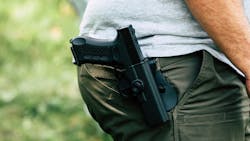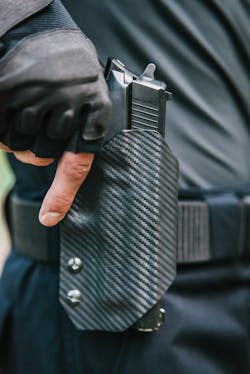Almost every conversation about Every Day Carry (EDC) will eventually include a discussion about holsters. What kind? What material? What carry position? What manufacturer? Just as there are many opinions about the best self-defense handgun, there are plenty of opinions about holsters, both for duty and for off-duty use. Since most duty holsters are either issued or specified by the agency involved, we’re going to focus on off-duty holsters for the purpose of this article.
This article appeared in the March/April issue of OFFICER Magazine. Click Here to subscribe to OFFICER Magazine.
Let’s start out by dispelling the myth that there is a single holster out there perfect for every carry circumstance, mode of dress and weapon. Realistically speaking, if there were, your duty holster would be your off-duty holster and the duty weapon would be your off-duty weapon and it would be carried/worn on your gun belt, etc. This simply isn’t realistic so set it aside. Everything from the weather, which determines your mode of dress to your expected activities impacts how you choose to carry your weapon. In fact, for many, it determines what weapon you choose to carry
In that vein, let’s briefly discuss “carry rotation.” There are many highly experienced, very knowledgeable guntoters who disagree with the notion of “carry rotation.” Their outlook is that you should be carrying the same defense handgun all the time—no matter what. The idea is that it should be the handgun you are most comfortable with, skilled with, confident in the performance of, etc. When you have identified and dedicated yourself to that weapon, all of your other decisions get made around it. In theory that’s a perfect outlook. In practice it might not be so easy. For the purposes of this article however, we’re going to assume that you usually carry a dedicated off-duty gun and if you don’t, that you only have one, two maximum, other handguns that you’d carry.
With those thoughts in mind, how many holsters do you need for each off-duty weapon? The two most popular carry positions are likely on the waistband (OWB) at the four o’clock position—just behind the right hip—and inside the waistband (IWB), right side between the hip and the belly button, usually referred to as appendix (IWBA) position.
The weapon can usually be concealed fairly easily in either position although experience has shown that a weapon carried IWBA is less likely to print—and show off where you’re carrying.
While there are some holsters out there that can be carried in either location without modification, most holsters are designed to be carried in a specific way: either OWB or IWB. There are a few modular holsters that allow you to use the same shell/holster body and different mounting systems so you can have, effectively, the same holster in different places on your body. This requires you to take the time to modify the holster day to day as you determine where you’re carrying the handgun. Mind you, we should all be striving to carry that same handgun in the same way day to day, but as mentioned, sometimes circumstances don’t work out that way.
At a bare minimum that means that you need two holsters for each handgun: one IWB and one OWB. That’s four holsters you have, and if your spouse also carries, potentially several more. If you modify the handgun to include a mounted light or a red dot sight, you may have to change holsters unless you planned ahead in your holster selection. If you’re not careful, you can end up with a dozen holsters fitting several different weapons, for carrying those weapons in different positions with different modes of dress. How do you organize the holsters? Searching through a drawer to find the one you’re looking for is never a pleasant experience.
One of the quickest and least expensive solutions is a door-hung clear shoe organizer. It may sound silly, but you can hang it over your closet door (on the inside) and see every holster that is held in it. With (usually) four clear pouches per row, you could have four holsters per weapon, using one row per weapon. Use how many ever rows you need to suit your carry rotation, and use the rest for shoes— like the item was designed for.
Another method is to have a dedicated drawer that holds your holsters in such a way you can easily identify which weapon the holster is for and what position it’s meant to carry the weapon in. If all of that sounds a little too OCD for you, you can always do what another writer has done for years: drop them all in a gym bag and dig through it looking for what you need, when you need it.
At the end of the day though, what you need is a holster that will probably secure your weapon of choice, in your carry location of choice, properly concealed by your mode of dress. It should afford a secure carry and quick/ easy access when you need it—but only to you.
This article appeared in the March/April issue of OFFICER Magazine.
About the Author
Lt. Frank Borelli (ret), Editorial Director
Editorial Director
Lt. Frank Borelli is the Editorial Director for the Officer Media Group. Frank brings 20+ years of writing and editing experience in addition to 40 years of law enforcement operations, administration and training experience to the team.
Frank has had numerous books published which are available on Amazon.com, BarnesAndNoble.com, and other major retail outlets.
If you have any comments or questions, you can contact him via email at [email protected].


